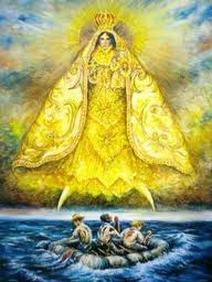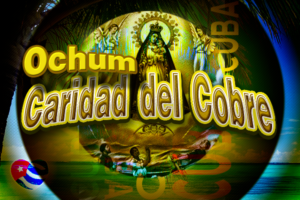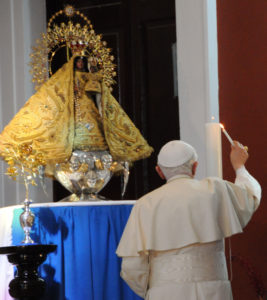![]() Felicia Valdés expected Thursday from nine days ago. Bought sunflowers, candles, honey and until some cigars for offer you to the santa in his house of Hialeah. With 56 years she says not identify is with the religion Catholic nor the Yoruba, but his confidence not it away of Cachita. To hundreds of kilometers of distance, in the city of the Havana, another Cuban is has to do it himself. Carmen Ruiz wants to pilgrimage to the sanctuary of our Lady of the charity of the copper with the hope of that your son out soon of the prison. To both sides of the narrow, the fiesta by the Virgin of the charity u Ochúm brings to the family Cuban.
Felicia Valdés expected Thursday from nine days ago. Bought sunflowers, candles, honey and until some cigars for offer you to the santa in his house of Hialeah. With 56 years she says not identify is with the religion Catholic nor the Yoruba, but his confidence not it away of Cachita. To hundreds of kilometers of distance, in the city of the Havana, another Cuban is has to do it himself. Carmen Ruiz wants to pilgrimage to the sanctuary of our Lady of the charity of the copper with the hope of that your son out soon of the prison. To both sides of the narrow, the fiesta by the Virgin of the charity u Ochúm brings to the family Cuban.
“Was the Virgin which I helped to get out of Cuba.” “She and his sister, Yemaya”, says Valdes about the time in that came to Florida to the win the giveaway of visas known as “the hype” in the island. Your comment reveals the amalgam between the religion Catholic and them pataquies (stories / legends) own of the religion yoruba brought to Cuba with them slaves of the West African.
A little history.
The Virgen de la Caridad de el Cobre, as the Catholic Church, venerated it is an image found by indigenous brothers Juan and Rodrigo de Hoyos with the black slave, Juan Moreno, around the year 1612. The testimony of Moreno, found hundreds of years later by the historian Cuban Levi Marrero confirmed the done. The charity, or Cachita, as also is you known is a devotion that represents to the Virgin Mary, mother of Jesus of Nazareth, to which holds in his hand left.
The Virgin of the charity of the copper, as it reveres the Church Catholic, is an image found by them brothers indigenous Juan and Rodrigo of hole next to the black slave Juan Moreno around the year 1612
It image, crowned by Juan Pablo II in his travel to the island in 1998 and to who the Pope Benedict XVI you gave it pink of gold of the Christianity in 2012 and the Papa Francisco visit the last year, was found in a table on them waters. Despite the storm that occurred in earlier days, their garments, according to the testimony of Moreno, were not wet and wood read “I am the Virgin of charity”.
With the step of the time and after different sites, the image was in the copper, a village Miner, that was the first place where is released to them slaves, eighty years before that in rest of the island. The physiognomy mestizo of the charity, allowed that the population black e indigenous is identified quickly with it and with the step of them centuries is was turning in a symbol of it Cuban by excellence.
Both Cuban as Spanish it took as patron in their armies, but it clothing of the first flag Cuban with them fabrics of your altar and the fervent prayer of Carlos Manuel of lawns, the father of the homeland, who put it cause mambisa and it Republic before their feet, leaned it balance in favor of them Creole.
In this 19th century is when it starts to spread devotion to charity throughout the island. Around 1870 the Camagüey priest Ricardo Arteaga called it in a sermon “lonely Star” in allusion to the patriotic symbol, so it had to go into exile.
Next to this devotion also begins the amalgam process known as syncretism, whereby the black slaves, identified the figure of charity with the image of the orisha Oshun, something that really happened in the Western Cuban and that has been spread with force after 1959.
Felicia Valdés, however, insists on calling the charity as Oshun.
“I the truth of religion don’t know much, but my a santero told me that I am (Oshun) daughter and everything I’ve asked always gives it me.” That is why I also am pleased her. In addition to the candles and them sunflowers more afternoon you buy a merengue and a panetela to put is it in water sweet. So always you’ve made. “Is my way of thanks”, explains.
OCHÚM, owner of sweet waters, is an orisha associated with love. He beautiful and mestizo face of the charity, United to his own name, that means love in latin, could have State in the genesis of the process sincretizador that has made almost impossible separate both interpretations on a same image.
The Virgen de la Caridad is symbol and synthesis of the Cuban nation. The first act of the Republic was held in the grounds of the shrine. In 1916 the Pope Benedict XV it proclaims Patron Saint of Cuba and to 1936, is crowned as Queen and mother of all them Cuban, by will express of the Pope Pio XI. The Virgin has traveled in two times all the island. The last pilgrimage, in 2011 made that from HIV patients up to inmates could receive visits from the mother of all Cubans.
Only maternal House cede political passions and resentments and hatreds. That is the symbolic value of the Virgen de la Caridad for many Cubans, apart from its religious importance. Are thousands them offerings that receives Cachita in its sanctuary in the copper: from the official of the Ministry of the Interior that is charge of suppress to the people, but you requests by the health of their children, until that Cuban that escapes of its island looking for freedom. Flowers on the altar are, perhaps for this reason better than anyone else, it is the perfect instrument to unite both sides of the Straits who are decades apart. Is Oshun or the charity, it true is that the Virgin attached to all them Cuban.
Agencies / 14ymedio, the Habana / Mario J. Penton / excerpts / Internet Photos / Arnold Varona, TheCubanHistory.com
THE CUBAN HISTORY, HOLLYWOOD.
![]() OCHÚM O ‘CACHITA’, UNA IMAGEN QUE UNE A LOS CUBANOS.
OCHÚM O ‘CACHITA’, UNA IMAGEN QUE UNE A LOS CUBANOS.
Felicia Valdés espera este jueves desde hace nueve días. Compró girasoles, velas, miel y hasta unos tabacos para ofrecerle a la santa en su casa de Hialeah. Con 56 años ella dice no identificarse con la religión católica ni la Yoruba, pero su confianza no la aparta de Cachita. A cientos de kilómetros de distancia, en la ciudad de La Habana, otra cubana se dispone a hacer lo mismo. Carmen Ruíz quiere peregrinar al santuario de nuestra Señora de la Caridad del Cobre con la esperanza de que su hijo salga pronto de la cárcel. A ambos lados del estrecho, la fiesta por la Virgen de la Caridad u Oshún reúne a la familia cubana.
“Fue la Virgen la que me ayudó a salir de Cuba. Ella y su hermana, Yemayá”, comenta Valdés acerca del momento en que llegó a Florida al ganar el sorteo de visas conocido como “el bombo” en la Isla. Su comentario delata la amalgama entre la religión católica y los pataquíes (historias/leyendas) propios de la religión yoruba traída a Cuba con los esclavos del occidente africano.
Un Poco de Historia.
La Virgen de la Caridad del Cobre, como la venera la Iglesia Católica, es una imagen hallada por los hermanos indígenas Juan y Rodrigo de Hoyos junto al negro esclavo Juan Moreno alrededor del año 1612. El testimonio de Moreno, encontrado cientos de años después por el historiador cubano Leví Marrero confirmó el hecho. La Caridad, o Cachita, como también se le conoce es una devoción que representa a la Virgen María, Madre de Jesús de Nazaret, al que sostiene en su mano izquierda.
La Virgen de la Caridad del Cobre, como la venera la Iglesia Católica, es una imagen hallada por los hermanos indígenas Juan y Rodrigo de Hoyos junto al negro esclavo Juan Moreno alrededor del año 1612
La imagen, coronada por Juan Pablo II en su viaje a la Isla en 1998 y a quien el Papa Benedicto XVI le regalara la rosa de oro de la cristiandad en 2012 y el Papa Francisco visitara el pasado año, fue hallada en una tabla sobre las aguas. A pesar de la tormenta ocurrida en días anteriores, sus vestiduras, según el testimonio de Moreno, no estaban mojadas y en la madera se leía “Yo soy la Virgen de la Caridad”.
Con el paso del tiempo y tras diversos emplazamientos, la imagen quedó en el Cobre, un poblado minero, que fue el primer lugar donde se liberó a los esclavos, ochenta años antes que en resto de la Isla. La fisonomía mestiza de la Caridad, permitió que la población negra e indígena se identificara rápidamente con ella y con el paso de los siglos se fue convirtiendo en un símbolo de lo cubano por excelencia.
Tanto cubanos como españoles la tomaron como patrona en sus ejércitos, pero la confección de la primera bandera cubana con las telas de su altar y la ferviente oración de Carlos Manuel de Céspedes, el Padre de la Patria, quien puso la causa mambisa y la República ante sus pies, inclinaron la balanza a favor de los criollos.
En este siglo XIX es cuando comienza a extenderse la devoción a la Caridad por toda la Isla. Hacia 1870 el sacerdote camagüeyano Ricardo Arteaga la llamó en un sermón “la Estrella Solitaria” en alusión al símbolo patrio, por lo que tuvo que marchar al destierro.
Junto a esta devoción también comienza el proceso de amalgama conocido como sincretismo, por el cual los negros esclavos, identificaron la figura de la Caridad con la imagen de la orisha Oshún, algo que realmente sucedió en el occidente cubano y que se ha visto extender con fuerza después de 1959.
Felicia Valdés, sin embargo, insiste en llamar la Caridad como OCHÚM.
“Yo la verdad de religión no sé mucho, pero a mi un santero me dijo que soy su hija (de Ochúm) y todo lo que le he pedido siempre me lo concede. Por eso yo también la complazco a ella. Además de las velas y los girasoles más tarde le compro un merengue y una panetela para ponérsela en agua dulce. Así siempre lo he hecho. Es mi manera de agradecer”, explica.
OCHÚM, dueña de las aguas dulces, es una orisha vinculada al amor. El bello y mestizo rostro de la Caridad, unido a su propio nombre, que significa amor en latín, pudo haber estado en la génesis del proceso sincretizador que ha hecho casi imposible separar ambas interpretaciones sobre una misma imagen.
La Virgen de la Caridad es símbolo y síntesis de la nación cubana. El primer acto de la República se celebró en los predios de su santuario. En 1916 el papa Benedicto XV la proclama Patrona de Cuba y hacia 1936, es coronada como Reina y Madre de todos los cubanos, por voluntad expresa del papa Pío XI. La Virgen ha recorrido en dos momentos toda la Isla. La última peregrinación, en 2011 hizo que desde enfermos de VIH hasta reclusos pudieran recibir la visita de la Madre de todos los cubanos.
Las pasiones políticas, los rencores y los odios solo ceden en casa materna. Ese es el valor simbólico de la Virgen de la Caridad para muchos cubanos, más allá de su importancia religiosa. Son miles las ofrendas que recibe Cachita en su santuario en el Cobre: desde el oficial del Ministerio del Interior que se encarga de reprimir al pueblo, pero le pide por la salud de sus hijos, hasta aquel cubano que escapa de su Isla buscando libertad. Las flores en su altar nunca faltan, tal vez por eso mejor que nadie, es el instrumento perfecto para unir ambos lados del Estrecho a quienes llevan décadas separados. Sea Oshún o la Caridad, lo cierto es que la Virgen une a todos los cubanos.
Agencies/14ymedio, La Habana/Mario J. Pentón/Extractos/Internet Photos/Arnoldo Varona, TheCubanHistory.com
THE CUBAN HISTORY, HOLLYWOOD.








